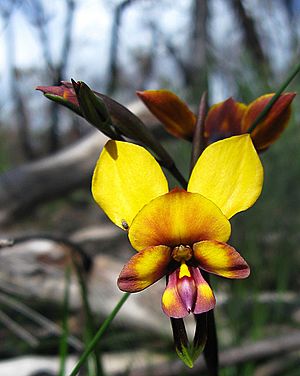Large pansy orchid facts for kids
Quick facts for kids Large pansy orchid |
|
|---|---|
 |
|
| Diuris magnifica growing in Kings Park | |
| Scientific classification | |
| Genus: |
Diuris
|
| Species: |
magnifica
|
The Large Pansy Orchid, also known by its scientific name Diuris magnifica, is a beautiful type of orchid. It grows only in the south-west part of Western Australia. This orchid is famous for its big, colourful flowers. You can often find it near the coast around Perth, growing alongside a similar but smaller orchid called Diuris corymbosa.
Contents
What Makes the Large Pansy Orchid Special?
The Large Pansy Orchid is a plant that grows from a special underground part called a tuber (like a small potato). It's a perennial herb, which means it lives for many years. This plant usually grows to be about 30 to 60 centimetres (12 to 24 inches) tall.
It has two or three long leaves that grow from its base. Each leaf is about 12 to 22 cm (5 to 9 in) long and 18 to 24 mm (0.7 to 0.9 in) wide. These leaves are folded lengthwise, which gives them a unique look.
The orchid produces between three and nine flowers on each plant. These flowers are a lovely mix of golden-yellow and purple. They are quite large, usually 40 to 60 mm (1.6 to 2.4 in) long and 30 to 50 mm (1.2 to 2.0 in) wide.
Let's look at the parts of the flower:
- The top part, called the dorsal sepal, is shaped like an egg. It's about 12 to 17 mm (0.5 to 0.7 in) long and curves upwards.
- The two side parts, called lateral sepals, hang downwards. They are long and narrow, about 16 to 26 mm (0.6 to 1.0 in) long.
- The petals stand upright. They have an egg-shaped blade about 20 to 30 mm (0.8 to 1.2 in) long.
- The labellum is the special lip-like part of the orchid. It's usually mauve or purple with some yellow spots. This part is about 13 to 18 mm (0.5 to 0.7 in) long and has three sections, or lobes. The middle lobe is wedge-shaped.
- There's also a small, yellow, ridged bump called a callus in the middle of the labellum.
This orchid looks a lot like other Diuris species, such as D. corymbosa. However, you can tell them apart by their size, when they bloom, and where they grow. The Large Pansy Orchid flowers from late August to October.
How it Got its Name
The scientific name for the Large Pansy Orchid is Diuris magnifica. It was first officially described in 1991 by a botanist named David Jones. He found a sample of the plant near Kwinana.
The word "magnifica" in its name comes from Latin. It means "noble," "eminent," or "splendid." This name was chosen because of the orchid's large, colourful, and impressive flowers.
Where Does it Grow?
The Large Pansy Orchid is quite common in the coastal areas of Western Australia. It likes to grow in shrubland and woodland habitats. You can find it between Lancelin in the north and Mandurah in the south. These areas are part of specific natural regions like the Geraldton Sandplains and the Swan Coastal Plain.
Sometimes, this orchid mixes with other types of orchids. In the northern part of its range, it can hybridise (mix its genes) with the Arrowsmith pansy orchid. In the south, it can hybridise with D. corymbosa.
Is it Safe?
Good news! The Western Australian Government's Department of Parks and Wildlife has classified Diuris magnifica as "not threatened." This means that, for now, there are enough of these beautiful orchids, and they are not in danger of disappearing.

